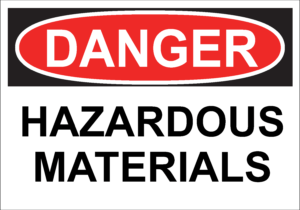Hazardous wastes can present challenges when they are shipped and moving hazmat waste not so simple. Because of this, getting hazardous wastes off of the dock isn’t as simple as slapping a standard shipping label on the container and waving goodbye to the carrier.
Fundamental requirements apply to everyone in the shipping chain: the generator who is offering the hazardous waste for shipment, the transporter(s) and the destination facility receiving the waste. Each must have an Environmental Protection Agency (EPA) number (40 CFR 262.18). Each must also receive appropriate Resource Conservation and Recovery Act (RCRA) and U.S. Department of Transportation (DOT) hazardous materials (hazmat) employee trainings so that personnel understand their roles and responsibilities for properly managing hazardous wastes.
Packaging, Labeling and Marking
Hazardous wastes must be properly packaged for shipping. The containers (drums, cans, cylinders, tank cars, bulk containers, etc.) must meet all applicable DOT shipping specifications in 49 CFR parts 173, 178 and 179.
Hazardous waste containers must also be properly labeled and marked in accordance with 49 CFR 172 (40 CFR 262.31-.32). This includes choosing the proper UN identification number for the waste as well as the correct labels to identify the waste’s hazard class(es). All containers must also be marked with the following verbiage found at 49 CFR 172.304:
HAZARDOUS WASTE: Federal Law Prohibits Improper Disposal. If found, contact the nearest police or public safety authority or the U.S. Environmental Protection Agency (Generator’s Name and Address, Generator’s EPA Identification Number, Manifest Tracking Number, and EPA Hazardous Waste Number(s).
Enjoying our insights?
Subscribe to our newsletter to keep up with the latest industry trends and developments.
Stay InformedManifests
Every hazardous waste shipment (40 CFR 262.20 a) requires a manifest, a specific shipping document that the small or large quantity generator prepares. It contains information about the generator, the materials being shipped, and the facility that will receive the wastes.
The EPA requires that shippers use the Uniform Waste Manifest Form 8700-22 for all hazardous waste shipments. This form must have at least four copies but typically has six copies to accommodate the record keeping needs of the generator, transporter(s) and destination facility. A generator choosing to make its own manifest must receive approval from the EPA director of the Office of Resource Conservation and Recovery (ORCR) and use approved resources for the printing.
Manifests may be either paper or electronic but electronic forms may only be used if the generator has already confirmed that everyone handling the waste (transporters and destination facility) can use an electronic manifest. If so, the generator must also provide the transporter with one paper copy (40 CFR 262.24).
Facilities must train the person preparing and signing manifests to completely and accurately supply the information needed. This person must know the facility’s EPA identification number, applicable UN identification number for wastes being shipped, EPA waste codes, emergency response information and any special requirements. That person must also be able to certify that the facility has a waste minimization program in place (if a large quantity generator) or that it is making a good faith effort to minimize waste production (if a small quantity generator) and be able to provide the transporter with appropriate placards for the delivery vehicle.
Each manifest must specify the name of the destination facility that is permitted to accept the wastes being shipped. In case that facility is not able to accept the waste, the manifest may also name an alternate facility. If neither of those destination facilities can accept the waste, the shipper must direct the transporter to return the waste or take it to a different facility.
When a shipment leaves the facility, the generator keeps the top copy of the manifest, signed by the generator and transporter, and gives all of the remaining copies to the transporter. Each transporter will keep a copy for its records and give the destination facility the remaining copies. After the destination facility receives the hazardous waste, it will return a copy of the fully signed manifest to the generator. The generator must keep this copy for at least three years.
If a large quantity generator does not receive the final copy from the destination facility within 35 days, that site must contact the transporter or destination facility to check the status of its shipment. If the final, signed manifest does not arrive within 45 days, site personnel must file an exemption report with the EPA. Small quantity generators who do not receive a final, signed copy within 60 days must file an exemption report (40 CFR 262.42). Sites must keep each manifest for three years from the date that the initial transporter accepted the waste for shipment.
Moving Hazmat Waste Not So Simple
Choosing the right types of shipping containers and marking them properly helps ensure that hazardous wastes will be transported safely. Coupling these efforts with complete, accurate manifests helps everyone involved understand the nature of the wastes that they are handling, and that helps protect both employees and the environment.





















